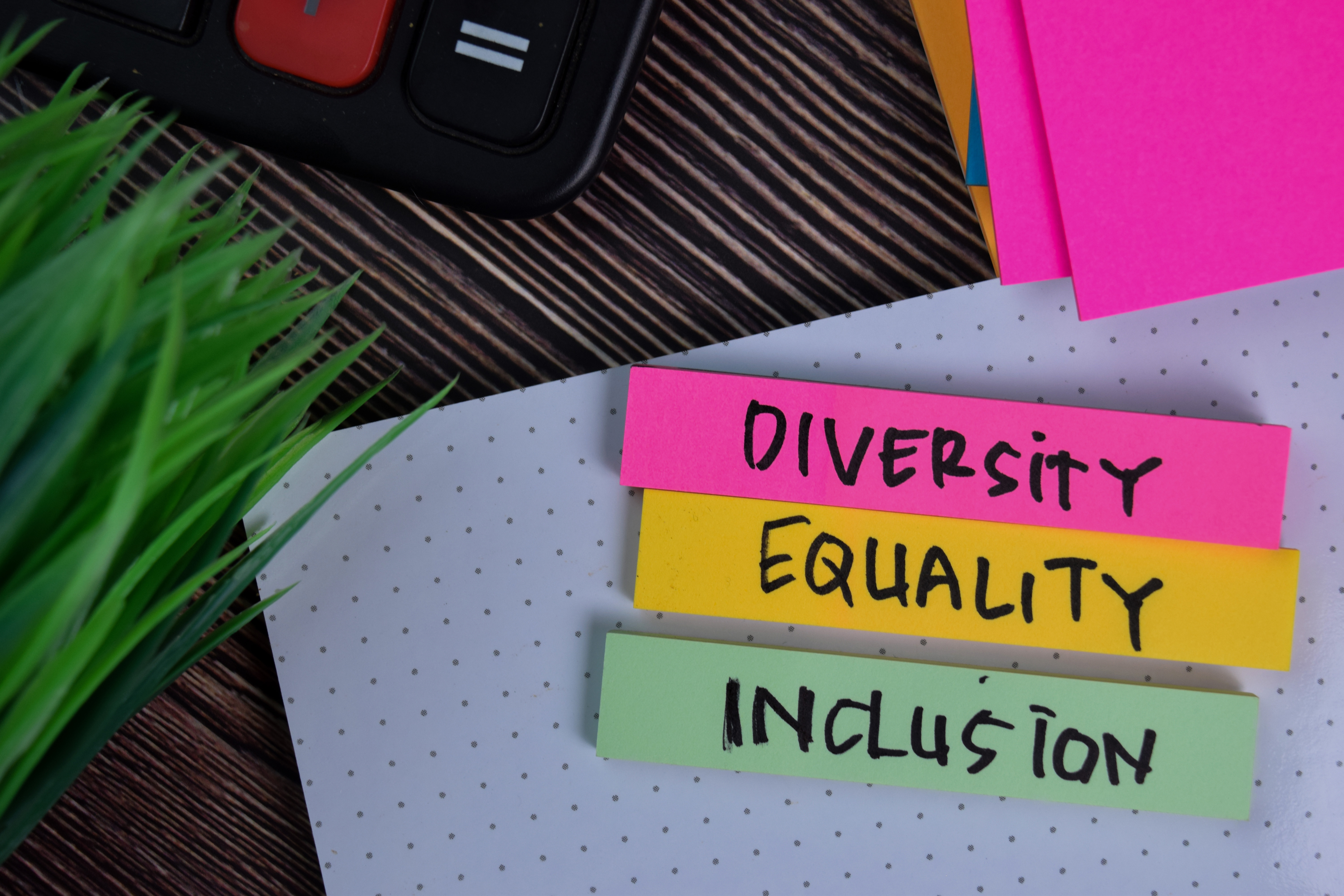In the modern workplace, the pursuit of equality, diversity, and inclusion (EDI) is not just a moral imperative but a competitive advantage. When people from different backgrounds, with different life experiences and ways of thinking come together, they challenge each other’s assumptions, spark creativity, and uncover insights that would otherwise remain hidden.
But what exactly is equality, diversity and inclusion? And how do you promote equality, diversity and inclusion in the workplace? Let's dive into a practical guide that unravels these concepts and leads to a genuinely inclusive workplace.
Jump to:
What is Equality, Diversity, and Inclusion?
At its core, equality ensures everyone has the same opportunities regardless of their background or characteristics. Diversity refers to the rich tapestry of human demographics, experiences, and traits within a group. Inclusion is the practice of making all members feel valued and integral to the organisation's success.
6 Strategies for Creating an Inclusive Workplace

Step 1: Understand and Embrace the Value of EDI
In an inclusive workplace, employees are more likely to be engaged with their work and committed to their organisation's vision, which leads to greater job satisfaction and loyalty. This isn’t just good for company morale; it translates into tangible business outcomes, such as higher productivity and profitability.
Here’s how you can start to build this understanding and appreciation within your company:
- Conduct EDI workshops: Organise workshops that highlight the importance of EDI. Use these sessions to explore the benefits of a diverse workplace, such as improved problem-solving and decision-making capabilities. Facilitators can use real-world case studies to demonstrate how diversity can lead to better business results and provide a safe space for employees to share experiences and ask questions.
- Implement equality and diversity courses for staff: Through comprehensive courses, such as our Equality, Diversity, and Inclusion Diploma Course, employees at all levels can gain an in-depth understanding of unconscious bias, cultural competence, and inclusive communication. By investing in continued education, your business shows its commitment to these values and the belief in their importance.
Step 2: Establish Clear EDI Principles and Goals
A foundational element of any effective diversity and inclusion strategy is the establishment of clear principles and concrete, achievable goals. These not only articulate the organisation's commitment to EDI, but also provide a benchmark against which progress can be measured and evaluated.
Crafting an EDI mission statement:
An EDI mission statement is a powerful declaration of your organisation's commitment to these values. It's a guiding star that should:
- Reflect Core Values: Incorporate the core values and ethos of your company. This statement should resonate with every member of the organisation, from the CEO to the newest hire.
- Inspire Action: It should move people to think, feel, and, most importantly, do.
- Be Visible: Display it prominently across your company materials, website, and workplace to remind everyone of the shared commitment.
Setting specific, measurable EDI targets:
With a mission statement in place, the next step is to set specific, measurable EDI targets. These targets should be:
- SMART: Specific, Measurable, Achievable, Relevant, and Time-bound. For example, rather than a vague aim to 'increase diversity,' set a goal to 'increase the representation of underrepresented groups in leadership positions by 20% within three years.'
- Comprehensive: Cover various EDI aspects, including recruitment, retention, training, and progression.
- Transparent: Make these targets known throughout the organisation and regularly report on progress. Transparency breeds trust and accountability.
- Dynamic: Be prepared to adjust your goals as your organisation and the world around it evolves. EDI targets should not be static; they should evolve as your organisation learns and grows.
Establishing these principles and goals helps to provide clear direction for the company and a framework within which all employees can work towards creating a truly inclusive environment.

Step 3: Cultivate an Inclusive Leadership
In any organisation, leaders are the catalysts for change and the role models for the workforce. Leadership training is pivotal in equipping your company's leaders with the necessary tools to understand and implement EDI effectively. Here's how you can approach this:
- Comprehensive learning programmes: Develop training modules that cover a wide array of EDI topics, including unconscious bias, privilege, allyship, and inclusive decision-making.
- Interactive sessions: Use workshops, role-playing scenarios, and group discussions to help leaders internalise EDI principles through practical application.
- Ongoing education: EDI learning is not a one-off event. Implement continuous learning opportunities to update leaders on the latest EDI research, trends, and practices.
To create a truly inclusive workplace, leaders need to be more than just participants in EDI training—they need to be its champions. Here’s how leaders can take active roles in promoting EDI:
- Open dialogue: Encourage leaders to engage in conversations with their teams about EDI, listen to concerns, and act on feedback.
- Leading by example: Leaders must walk the talk. This means being mindful of their language, challenging discriminatory behaviours, and advocating for underrepresented groups.
- Recognition and reinforcement: When leaders celebrate successes related to EDI and call out good practices, it reinforces the importance of these efforts.
With the commitment of inclusive leaders, an organisation's EDI principles are not just words on a page but actions that shape the daily experience of all employees. Training and encouraging leaders to embody and advocate for EDI is a powerful step in making the workplace more equitable and inclusive for everyone.
Recommended for you!
Best SellersStep 4: Foster Open Dialogue and Education
Open dialogue and continuous education are essential for creating an environment where equality, diversity, and inclusion are not only encouraged but are living, breathing aspects of everyday work life. Here’s how you can incorporate these elements into your workplace:
- Scheduled discussions: Establish a recurring calendar event for EDI discussions, ensuring they are a consistent priority.
- Safe spaces: Create a safe, open environment for employees to share their experiences and perspectives on EDI-related issues.
- Diverse perspectives: Rotate discussion leaders to ensure a variety of viewpoints are heard and to prevent any single narrative from dominating.
- Actionable outcomes: Encourage each meeting to have a clear purpose and conclude with actionable takeaways contributing to the organisation's EDI goals.
- Guest speakers and workshops: Bring experts and advocates who can share insights and lead interactive sessions on specific EDI themes.
By fostering a culture of open dialogue and continuous education, you ensure that EDI remains an active and ongoing conversation, not relegated to annual training sessions or forgotten in day-to-day operations. It also means that every employee can grow their understanding and actively participate in the company’s EDI journey.
Step 5: Develop and Implement an Inclusive Hiring Strategy
An inclusive hiring strategy is not just about attracting a diverse range of candidates; it's about ensuring that the hiring process itself is equitable, free from bias, and structured to give all applicants a fair chance of success. Here's how it can be done:
- Use blind recruitment: This technique eliminates unconscious biases that can influence the hiring process. It anonymises applications to remove names, gender, age, and other personal identifiers so that the initial screening is based solely on qualifications, experience, and skills. By focusing on the candidates' abilities and fit for the role rather than personal characteristics, you can create a level playing field that allows talent to stand on its own merits.
- Encourage diverse interview panels: This ensures that various perspectives are considered in the hiring decision. Include panel members from various backgrounds, departments, and levels of seniority to bring different viewpoints to the table. Establish clear criteria for feedback on candidates and require that all panel members provide their observations independently to avoid being influenced by dominant voices.
- Tailor job descriptions to reflect your commitment to EDI: This sends a message to potential applicants about the kind of workplace culture they can expect and attracts individuals who share these values.
- Encourage underrepresented groups to apply: Broaden your recruitment reach by partnering with organisations and educational institutions that work with underrepresented groups and attending job fairs that focus on diversity. By taking these steps, you ensure that your recruitment process isn't just about filling vacancies but about building a workforce that truly embodies diversity and harnesses the strength that comes from a range of experiences and perspectives.

Step 6: Measure, Evaluate, and Evolve Your EDI Efforts
To truly embed equality, diversity, and inclusion in the workplace, it's crucial to establish a cycle of continuous improvement. This requires a commitment to measuring, evaluating, and evolving your EDI strategies over time, which can be done by:
- Conducting regular employee feedback sessions: Regular sessions where employees can share their experiences and perceptions can help the organisation understand the effectiveness of its initiatives. Implement surveys, focus groups and one-on-one meetings.
- Storing and monitoring your data: Data can illuminate the successes and failures of your EDI initiatives, turning subjective experiences into objective analysis. Keep track of representation metrics, retention and progress rates, and all hiring data.
This cycle of measuring, evaluating, and evolving is not a one-time effort but a continuous commitment to growth and improvement. By setting quantifiable goals and using data to track them, you create a transparent, accountable process for assessing your EDI efforts.
Your Next Steps to a More Inclusive Future
Committing to equality, diversity, and inclusion is not just about improving your workplace environment; it's about preparing your business for a better future. If you want to deepen your understanding or lead the change within your organisation, education is key.
The Centre of Excellence offers an in-depth Equality, Diversity, and Inclusion Diploma Course that can equip you with the knowledge, skills, and confidence to drive meaningful change. Whether you're an individual seeking personal growth or a company leader wanting to make a significant impact, our course is designed to support learners at all levels.
Take the step today towards a more inclusive tomorrow. Enrol in our EDI course today for a reduced price of £29 and join a community that's reshaping the world, one workplace at a time. Let's build workplaces where diversity is celebrated, equality is the norm, and inclusion is a way of life. Discover more of our business, marketing and PR courses, and start your journey with the Centre of Excellence.













